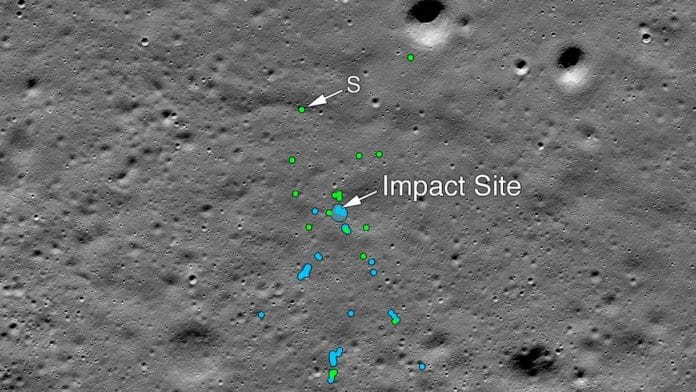Bengaluru: An Indian engineer aided NASA’s Lunar Reconnaissance Orbiter (LRO) team in its discovery of the impact site of Chandrayaan-2’s lander, Vikram.
In a statement issued Tuesday, NASA said a tip from Chennai-based Azure developer Shanmuga Subramanian helped the LRO team identify the location of the lunar lander, which attempted a soft landing on the moon on 7 September.
The LRO team identified the location of Vikram’s impact site by comparing the before and after pictures of the spacecraft’s overhead pass, first taken by NASA on 17 September and released on 26 September.
Subramanian analysed these pictures and emailed the LRO team with his identification of the debris field, the statement said.
Using his tip, the LRO team studied image sequences obtained on 14 October and 11 November, and was able to identify the impact disturbances in the lunar regolith (soil) and pieces of debris from the lander strewn on the surface.
The lander crashed close to the expected site of landing — the impact site’s coordinates are 70.8810°S, 22.7840°E, while the expected landing coordinates were 70.9°S, 22.7°E.
Also read: ISRO plans second attempt at soft landing on Moon for November 2020
‘Calculated from NASA data’
Speaking to ThePrint, Shanmuga Subramanian said after NASA released the first image, he found the expected coordinates on ISRO’s live stream of the attempted soft landing and social news aggregation platform Reddit.
“From ISRO’s live television data, I calculated how far Vikram could have landed from the landing location as each pixel is equal to 1.25m and each square is 1.25km in length in NASA’s image,” Subramanian told ThePrint.
“I decided to search around 2×2 sq km area around the expected landing coordinates and concentrated my efforts north of landing point, as Vikram approached the (designated) area from the North Pole,” he added.
Subramanian posted his findings on micro-blogging site Twitter on 3 October. He also tweeted it to ISRO’s official account, he said.
Is this Vikram lander? (1 km from the landing spot) Lander might have been buried in Lunar sand? @LRO_NASA @NASA @isro #Chandrayaan2 #vikramlanderfound #VikramLander pic.twitter.com/FTj9G6au9x
— Shan (Shanmuga Subramanian) (@Ramanean) October 3, 2019
Subramanian subsequently wrote to NASA. The LRO team acknowledged his email and credited the tip to him in its statement Tuesday.
@NASA has credited me for finding Vikram Lander on Moon's surface#VikramLander #Chandrayaan2@timesofindia @TimesNow @NDTV pic.twitter.com/2LLWq5UFq9
— Shan (Shanmuga Subramanian) (@Ramanean) December 2, 2019
“The debris first located by Shanmuga is about 750 meters northwest of the main crash site and was a single bright pixel identification in that first mosaic (1.3 meter pixels, 84° incidence angle). The November mosaic (image) shows best the impact crater, ray and extensive debris field,” NASA said in its statement.
In its images, the three largest pieces of debris are each about 2×2 pixels and cast a shadow of size one pixel.
After 7 September, when ISRO lost communication with Vikram lander, the Indian space agency’s only official statement said it was still attempting to re-establish communication. However, leaked statements said ISRO discovered the lander in a single piece but tilted.
The Modi government told Parliament only last month that the spacecraft underwent a “hard landing”.
The Chandrayaan-2 orbiter around the moon is still intact and functioning as expected, with an extended lifespan of 7 years. Meanwhile, ISRO is once again eyeing a lunar landing by this time next year.
Also read: Discovery of water on moon: What India’s first Chandrayaan mission achieved a decade ago







The Chandrayan 2 mission was launched by ISRO on June 22 and 7 September , 2019. The mission had planned soft landing of Vikram Lander on lunar surface. When Vikram Lander was just within touching distance from landing on the Moon surface , the ground stations lost communications with it , suggesting that mission has broken just a little before spectacular success. Now , there has come a news in early December 2019 that NASA has found the debris of Vikram Lander with the help of an Indian Teche. What is notable here is that after receiving a material , substantial and precise tip from Chennai-based Indian Space enthusiast Shanmuga Subramanian , the LROC team of NASA made about four attempts to identify the images. It has been said by NASA that the November mosaic had the best pixel scale and lightening conditions. In other words , they were much satisfied with November 2019 images. The news of debris of Vikram Lander having been found in November 2019 with the precise , substantial and material help of said Indian Space enthusiast from Chennai has strengthened and reassured chances of this Vedic astrology writer’s related prediction coming accurate. Through article – “ Predictions for coming year 2020 by kushal kumar” – published on 10th October , 2019 at theindiapost.com , this writer had predicted that during second half of 2020 , there is likelihood of a significant success in space program of India , bringing name. It may be observed here that the predictions were made in or around first week of October 2019. This fact has been mentioned in the article by saying – “ The year 2020 is nearly three months away”. And some glimpse of what has been described in the said article for 2020 , both uneasy and heartening , was to show up in its own way and extent , during October-December 2019 in accordance with the often used proverb – coming events cast their shadow before. It may be agreed that economic slowdown has reportedly begun early in April 2019 onward. But major worrisome concern on this count in the country and its intense coverage or coming out in news media appropriately happened in October and after in 2019. The Govt also reportedly took a number of elephantine measures to deal with the economic slowdown appropriately in October –November 2019 and may likely take more in days to come. So some glimpse in some shape seems to be there from October-December 2019 about coming year 2020.